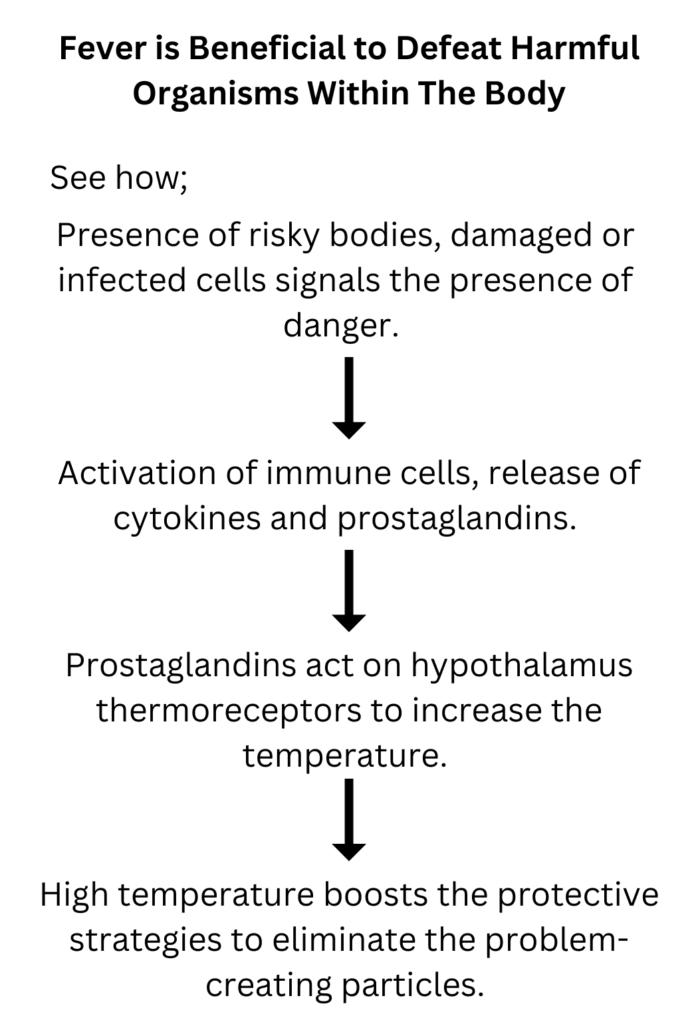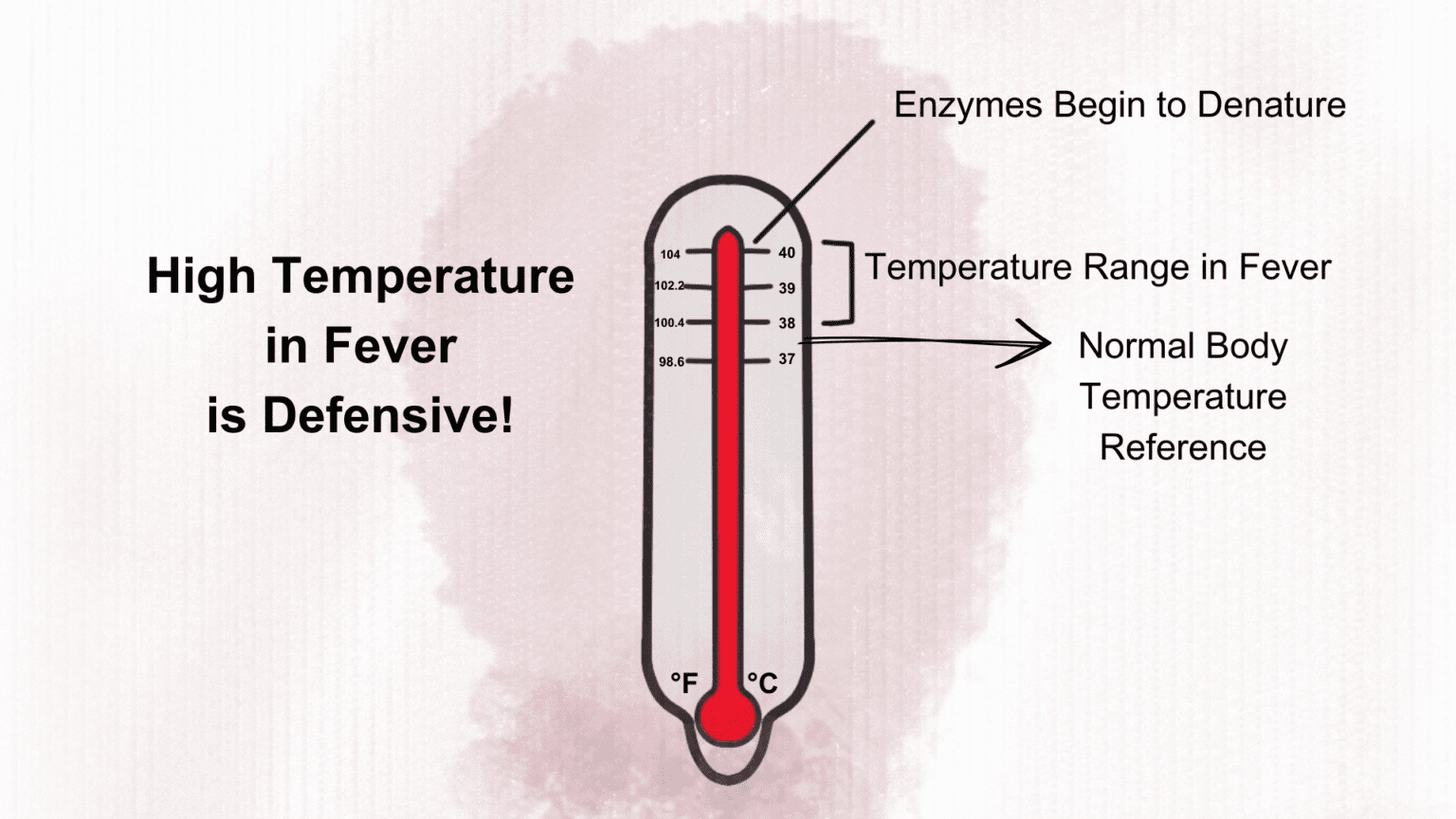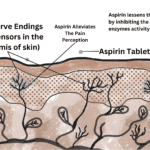High temperature in fever is a medical condition that arises when body temperature goes beyond the optimal limit. The optimal body temperature is 37°C (98.6°F). All body processes need this optimal temperature range of 36.1°C to 37.2°C (97°F to 99°F) for ideal effectivity. Sperm production is an exceptional process that needs a little bit cooler temperature than 37°C. That’s why, testes are attached to the outside of the body. All enzymes work best at this temperature. However, enzyme performance varies directly with temperature to an extent. When the temperature rises, enzyme performance is also enhanced, but if the temperature keeps rising beyond 40°C, enzymes will start to denature.
Fever is not an illness itself, rather it is a protective mechanism for the body. When unknown entities intrude into the body and they have the potential to cause serious threats, the body starts activating protective mechanisms. Fever is one of these protective mechanisms. Fever activates the immune cells to reach the site where they are needed to perform their role. High temperature in fever is a worth-protective strategy and it involves complex background details. But, we will not go very deep into these complex details. We will try to understand the philosophy of high-temperature induction as a natural protective strategy.
Fever Inducers- Prostaglandins
Prostaglandins are lipid compounds, derived from arachidonic acids by the action of cyclooxygenase enzymes. Prostaglandins are divided into different series such as PGD, PGE, and PGF series. In addition to these series, various other prostaglandins are also known. PGE2 of the PGE series is fundamental in fever induction.
The body sends signals to synthesize PGE2 in response to infection, inflammation, intrusion, or invasion of a threatening particle. PGE2 activates physiological changes to elevate the body temperature (details of how PGE2 induces fever are given later in this blog). So, prostaglandins can be termed fever inducers because they play the main role in elevating body temperature from the set point. From this contribution of prostaglandins, you can estimate the importance of these lipid compounds. NSAIDs stands for Nonsteroidal Anti-Inflammatory Drugs (NSAIDs) are a group of chemicals, particularly medicines, that can directly influence the Cyclooxygenase (COX) enzyme activity and thus affect the production of prostaglandins. One such famous medication is aspirin.
Why Prostaglandins are Released in the Body?
Prostaglandins are not only limited to fever induction. Moreover, they are compulsory for various routine physiological processes. While PGE2 is specifically related to fever, infection, or inflammation, other prostaglandin series regulate muscular contractions, including uterine muscle contractions and voluntary smooth muscle contractions. Prostaglandins have an influential impact on gastrointestinal health, as they help in mucosal secretion of the gut lining. So, medications that inhibit prostaglandin synthesis to reduce fever or pain, can also impact routine physiological processes. You can read Aspirin has both beneficial and disturbing effects. Aspirin directly impacts the metabolic enzymes which are the primary figures for prostaglandin synthesis. In this way, aspirin can bring high temperature in fever down but also affect other vital processes.
High Temperature in Fever – A Protective Strategy (Also Natural)
Our body systems work together to maintain the optimal environment within the body. When some microorganisms, which can be the macro ones, enter the body after defeating the first line of defense (skin), the brain responds actively to eliminate them. Other than foreign particles, some entities are already present in the body which have to be removed. Examples of such entities are the infected cells or unknown mass of cells. Most of the time, extruder pathogens are the fundamental stimuli for fever induction. Prostaglandins raise the body temperature and cause fever due to the following reasons;
Creating an Inhospitable Environment for Pathogens
Extruder organisms (pathogens) also need an optimum temperature for their efficient functioning. When body temperature goes beyond the ideal set point, the body creates an inhospitable environment for pathogens. Such temperature elevation can affect pathogen proliferation and biological activities. This, in turn, contributes to the slowness of the pathogen’s activity and guards the body to some extent.
Increased Metabolic Rate
Apart from providing an unfavorable environment to pathogens, high temperature in fever majorly contributes to the high metabolic activity. Due to the raised temperature, more energy is provided to the biochemical reaction. When temperature is raised, it is a sign of high energy and activity due to increase in stability. This makes the biochemical reactions to occur at a faster rate.
Vital biochemical reactions, in the aspect of fever, are increased proliferation and activation of immune cells, including lymphocytes, macrophages, antibodies, cytokines, etc. The high metabolic rate of immune cells helps in the destruction of harmful particles. Lymphocytes include T cells and B cells.
T- T-lymphocytes recognize antigens that are presented on antigen-presenting cells. Antigens are specific proteins that the body has to eliminate. While B-lymphocytes contribute to the production of antibodies. Antibodies attach to these antigens and neutralize them. Other white blood cells, such as macrophages and dendritic cells are known as antigen-presenting cells (APCs). They derive the antigens (harmful proteins) from pathogens or infected cells which have to be neutralized and presented them to killer cells. Under elevated temperatures, the body increases the efficiency of these reactions and makes the changes occur timely.
Increased Production of Chemokines
Chemokines are the molecules that assist the movement of cells around the body. Immune cells reach the site of infection or inflammation through a process, called chemotaxis. Chemotaxis is the specific signaling process in which infected sites or damaged cells send signals to the immune cells to reach the required site. Chemokines help in this movement. High temperatures in fever enhance the chemokine production and its release, facilitating the recruitment of immune cells at the site of inflammation. The heightened metabolic rate in fever provides more energy to generate chemical energy (ATP) and aids in cellular motility.
Efficient Enzyme Functioning
An increase in enzyme activity is the core purpose of fever. Enzymes work optimally at 37°C. But, if the temperature goes above 37°C, their functionality rises. The rise in enzyme activity is limited to a one or two-degree rise in temperature (such as 39°C degrees Celsius or 40°C. If the temperature keeps rising above 40°C it would be disastrous, as enzymes get denatured. So, a little rise in body temperature as occurs in fever is proved beneficial to the enzyme’s functioning.
Enzymes assist almost every biochemical reaction in the body. When enzyme activity rises, it makes the rate of biochemistry reactions fast. Some reactions that are described above, such as the production or proliferation of immune cells, or formation of antibodies, and enhanced mobility of chemokines, are assisted by efficient enzyme functioning.
So, a high temperature in fever are not for you to only suffer pain and discomfort. But, it assists your body in fighting against abnormal cells or pathogens. If these cells or bodies are not removed from the body, they will pose grave threats to the physiological systems. A rise in temperature is only a protective strategy to boost the recruitment of immune cells, amplify the activity of antigen-presenting cells, lymphocytes, and other immune cells, increase enzymatic activity, etc.
How Prostaglandins Make the Body Temperature High?
When infection or inflammation persists due to the presence of damaged cells or intrusion of unknown risky bodies, immune cells secrete cytokines. Cytokines are small glycoprotein molecules that are involved in cellular signaling processes. They coordinate the immune responses and play a background role in normal regulation of the immune system. They can also have other roles in the body but here we will remain stuck to the immune system. Interleukin -1 (IL-1) and Tumor necrosis factor-alpha (TNF-alpha) are the two cytokines that are actively involved in the temperature elevation during fever.

Interleukin-1 and tumor necrosis factor-alpha act on specific receptors in the hypothalamus. When these cytokines act on the hypothalamus, particularly thermoregulatory receptors, they provoke the production of prostaglandins. Prostaglandins, specifically PGE2, are thus produced by the action of interleukin-1 and tumor necrosis factor-alpha. PGE2, then directly acts on the EP3 receptors of the hypothalamus. This action causes the rise in temperature from the set point.
The hypothalamus is beneath the thalamus and a part of the forebrain. It has active participation in the temperature regulation. Thus, when prostaglandins (the fever inducers) act on specific receptors of the hypothalamus, they upregulate the body temperature.
You can also read the verified article about how the presence of inflammation induces fever. This scientific article is a reference that how prostaglandins act on hypothalamus and induce fever.

Let’s Conclude It
The body induces fever to encounter menacing organisms. Fever helps the body in eliminating these abnormal bodies and regain the body’s optimal settings. For this purpose, temperature is raised and pain receptors become more sensitive. All attribution goes to cytokines and prostaglandins. Although they do not directly participate in fighting off risks, they do help in the regulation and coordination of immune responses. In fact, cytokines and prostaglandins are central players in the initiation of immune response. They make the brain and body aware of a risk.
Prostaglandins also cause the sensation of pain in the presence of an infectious stimulus to make the brain aware of an anomaly. Ergo, we assume fever is only suffering and pain. To overcome come, we rely on several medications. These medications are good for some purposes, but most of the time, fever is a natural response and should be naturally encountered.




